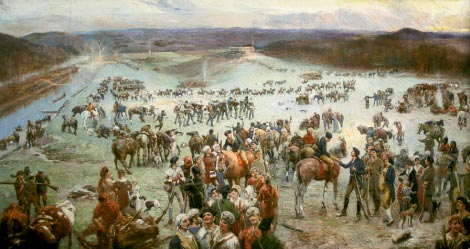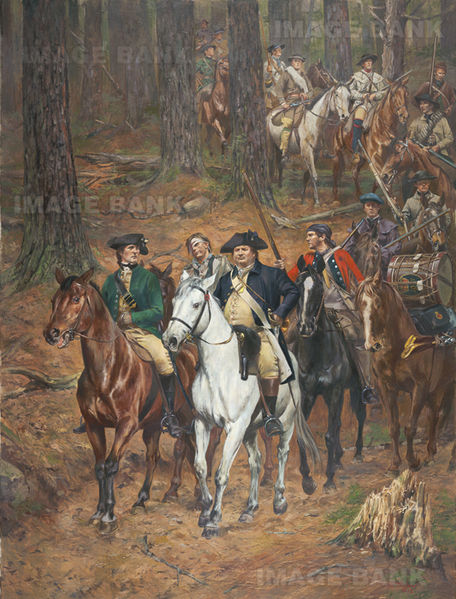
|
Although they had cleared land, built cabins and brought up children in adjacent states the distance between their homesteads (that would be merely a partial day’s drive in modern times) was so significant it is unlikely they would have shared the same spot of land without such a dire threat to their freedom. Those two ancestors shared the victory of King’s Mountain. Marching to the battle from eastern Tennessee and from North Carolina, respectively, they accomplished the defeat of the despised young British Major Patrick Ferguson. Ferguson was young, boastful, brash, and talented. No dummy, he was the inventor of the Ferguson Rifle. (*) He was from Scotland but fought for the British Army. He was so antagonistic toward Patriots and, reportedly, harsh in his treatment of those he encountered that his name became a rallying cry that ultimately led to his defeat and death at the Battle of King’s Mountain.
Colonel Cleveland's War Prize Oct. 7, 1780

|
(*) The Ferguson rifle was one of the first rifles to be put into service by the British military. It fired a standard British carbine ball of .615 caliber and was used by the British Army in the American War of Independence at the Battle of Saratoga in 1777, and possibly at the Siege of Charleston in 1780.[1] Its superior firepower was unappreciated at the time because it was too expensive and took longer to produce – the four gunsmiths making Ferguson's Ordnance Rifle could not make 100 in 6 months at four times the cost per arm of a musket.
The action was adapted from the earlier 1720 Isaac de la Chaumette design by Major Patrick Ferguson (1744–1780), who redesigned it around 1770. He received an English patent in December of 1776 (number 1139) on details of the design. The largest battle in which the rifles were used was the Battle of Brandywine, in which Ferguson was wounded. SOURCE: Various extracts from Wikipedia at: https://en.wikipedia.org/wiki/Ferguson_rifle (**) Over-the-Mountain Men (deriving from Westernmost North Carolina, now East Tennessee, and now Southwest Virginia), according to Professor Lyman C. Draper, the noted Frontier historian, in his authoritative book Kings Mountain and Its Heroes (1881)
And the mention of Major Patrick Ferguson leads me to a further intertwining of lives and fortunes among my direct bloodline ancestors. Ferguson had adapted a rifle designed in 1720 and patented in December of 1776 as the Ferguson Rifle. “The largest battle in which the rifles were used was the Battle of Brandywine, in which Ferguson was wounded.” And research has disclosed that my 5th Great Grandfather, paternal line, Joshua Logan Younger, after surviving the deathly winter at Valley Forge, fought under General George Washington at the Battle of Brandywine. There he received a permanently disabling injury – possibly from one of those Ferguson rifles. Joshua Younger’s pension application of 6 Oct 1821 (Nicholas County, Kentucky) attests to that wound being the basis of his plea for recompense. (See attached my transcription of the original application.)
Kentucky, Nicholas County (to-wit)
Joshua Younger appeared before me, a Justice of the Peace for said
County and made oath that he entered in the year 1777 in Capt. Volpes –
Company of the 12th Virginia Regiment of the Continental line commanded
by Col. Wood for during the war and that he continued in service until
he was wounded in the Battle of Brandywine and was honorably discharged
at the Barracks at Winchester in the year (blank) by Col. Wood on
account of his being disabled by said wound and that he has never rec’d
nor sought bounty for said services.
His
Joshua Younger
Mark
Sworn to and subscribed before me and I certify that the deponent Joshua
Younger is a credible witness on oath given under my hand on this 6th
day of Oct. 1821.
John Carter JofP
Kentucky, Nicholas County (to-wit)
James Fitchpartrick a credible person on oath declares on oath that he
was in the same Company and Regiment with the above named Joshua Younger
in the Revolutionary War and well knows that said Younger enlisted for
during the war in the 12th Virginia Regiment as he has just stated in
his affidavit and that he knows that sd. Younger was honorably
discharged in the year 1780 of inability on account of a wound he rec’d
in the Battle of Brandywine and that he knows this to be the same Joshua
Younger ----
His
James Fitchpartrick
Mark
Sworn to and subscribed before me this 6th day of October 1821
John Carter JofP
Joshua Younger
Mark
John Carter JofP
Kentucky, Nicholas County (to-wit)
James Fitchpartrick a credible person on oath declares on oath that he was in the same Company and Regiment with the above named Joshua Younger in the Revolutionary War and well knows that said Younger enlisted for during the war in the 12th Virginia Regiment as he has just stated in his affidavit and that he knows that sd. Younger was honorably discharged in the year 1780 of inability on account of a wound he rec’d in the Battle of Brandywine and that he knows this to be the same Joshua Younger ----
James Fitchpartrick
Mark
The coincidences of association do not end here; however. In my research, I discovered that both Joseph Bullard and Martin Davenport were friends with Waightstill Avery and his son, Isaac T. Avery: In those same letters to Draper, (correspondence between Lyman Draper author of the book "King's Mountain and It's Heroes" and J.C. Harper of Patterson, NC.), W. W. Lenoir says of Capt. Martin Davenport, "He was a good hunter as well as a favorite soldier and scout of Cleveland and was in afteryears a favorite with Waightstill Avery and his son Isaac T Avery. He was often a welcome guest at their hospitable abode.”
Joseph Bullard would have a professional relationship with Waightstill Avery: Waightstill Avery represented Joseph Bullard in a North Carolina courtroom where Joseph was charged to uphold his commitment to serve in the Continental Army for the duration of the revolutionary war. Avery won the case; Joseph Bullard was serving with Colonel John Sevier, who would become the first Governor of the State of Tennessee in 1796.
Waightstill Avery played a large role in North Carolina history. Born in Norwich, Connecticut, he studied law at Princeton. He later emigrated to North Carolina where he was licensed to practice law in 1769. He settled in Charlotte and in May of 1775 when the first rumblings of revolution were heard in that state, he became one of the signatories of the Mecklenburg Resolves, basically a document declaring independence from the British rule. Cornwallis, in his wrath at that “affrontery” would order the law office of Waightstill Avery to be burnt to the ground – and it was, all documents, law library, and equipment and furnishings. Avery would; however, show his resolve by serving with the North Carolina militia. When then Governor of Virginia, Patrick Henry, issued the Treaty of Long Island of Holston, 20th July 1777, Governor Caswell (North Carolina) named among his appointees, Waightstill Avery. Waightstill would go on to serve as the first Attorney General of the State of North Carolina, a position that he resigned after some disagreements among the militia members of Jones County. He then moved to Burke County in 1781 where he remained until his death in 1921. (SOURCE: Historical Sketches of North Carolina from 1584 to 1851, Vol. II)
In 1972, in Dallas, Texas, your author would meet Tod Robinson Collett, III, the 4th great nephew of Waightstill Avery (and the great-great grandson of Tod Robinson Caldwell, the first governor of the State of North Carolina. Gov. Caldwell was also an attorney and resided for many years in Morganton, Burke County, North Carolina.) When we met, I was employed as the legal secretary and paralegal to Bill E. Brice, an attorney of great intellectual and strategic planning capabilities. Tod was at that time the President of a subsidiary of Carterfone Communications Corporation which was then headed by James K. Devlin and chaired by Bill Brice. Mr. Brice’s representation of Carterfone in a case against AT&T would bring not only fame, but provide a landmark decision in law that still affects no less than three major specialties of law: communications, engineering, and monopoly. After several years of a professional association, Tod and I enjoyed a close personal relationship for a number of years following his divorce from the delightful Suzie Wigginton.
These fascinating coincidences (is there such a thing as coincidence?) would never have become known to me without my love of genealogy and my drive to always pursue the story behind the facts. Through in-depth research of each person within my tree and my desire to confirm the facts, I often go beyond the normal search methodology and consider all the ways in which I can learn more about the person whose life I am revealing. Through the Internet we are given a virtually limitless source of material to bring each of the names on our tree to life. Use that resource! Think creatively to dig out those facts that seem elusive or intrigue your mind. There is no end to the satisfaction to be gained through armchair genealogy.






No comments:
Post a Comment